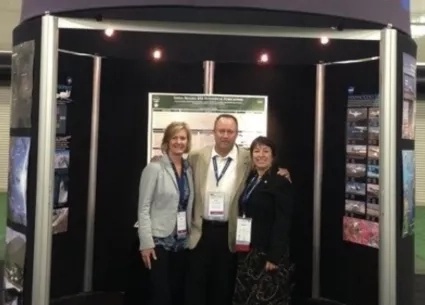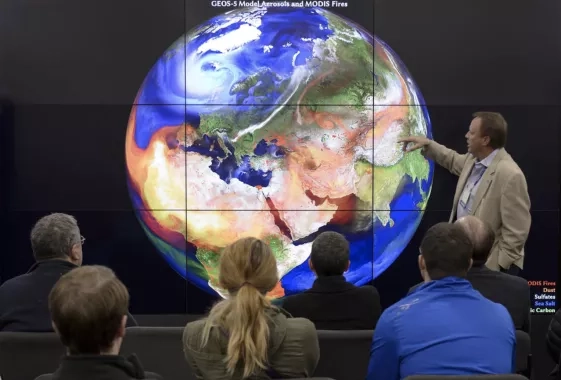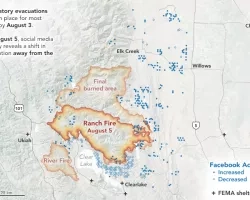Vince Ambrosia has been “putting out fires” at NASA for more than 42 years. He’s an expert in studying wildfires using aircraft and satellites, and now he’s hanging up his fireman’s hat and retiring. Looking back at his decades-long career at NASA, Ambrosia says it feels like “a ride through history.”
Ambrosia finished his graduate studies in remote sensing at the University of Tennessee, Knoxville in 1980. The same year, he started working at NASA Ames Research Center in Mountain View, California. In those early days, scientists were still doing remote-sensing data analysis on punch cards. Over the following decades, Ambrosia was at the forefront of advances in the field. He saw the rapid evolution of uncrewed aerial vehicles, or UAVs, and data processing technology. And he searched for civilian applications for these emerging capabilities. In fact, he won a 2009 NASA Outstanding Public Service Medal for his work on emergency wildfire observations with UAVs and sensors.
A few years before that award, Ambrosia worked on one of his most thrilling projects, NASA Ikhana, a remotely piloted Predator B UAV adapted for civilian science. Ikhana flew over multiple fires beginning in 2007 as part of the Western States Fire Mission, a joint undertaking from NASA and the U.S. Forest Service. Ambrosia led the team that developed the onboard sensors that could peer through thick smoke and haze to detect hotspots. These sensors relayed information to the incident command centers on the ground in map-ready format within a matter of minutes.
“That was probably the most exciting time in my life because it was so groundbreaking,” Ambrosia says. “We were the first civilian unmanned aerial vehicle to ever fly freely throughout the national airspace in the United States.”
“Vince delivered firsts,” says Rob Sohlberg, who worked with Ambrosia at NASA Applied Sciences Wildland Fires program. “He delivered the first Certificate of Authorization for UAS flights in the civilian airspace. And then the first continuous UAS wildland fire monitoring mission spanning the Canadian to Mexican borders.”
Because he spent so much of his career working with partner entities like the U.S. Forest Service, Ambrosia says his work with NASA Applied Sciences has been another professional highlight. For the last decade, he has served as associate program manager for NASA Applied Sciences’ Wildland Fire program area.
“I was an applications development person and a communicator with our partners in the fire community for so many years," he says. "I saw this as an opportunity to really promote NASA Earth observation tools."
The relationship between NASA and the U.S. Forest Service dates to the 1970s, and Ambrosia helped that partnership mature. Now the two agencies meet twice a year. They work together to advance the technological capabilities that are coming out of our Earth observations community and integrate those capabilities into real-life operations in fire management.
Ambrosia’s commitment to collaboration earns him praise from colleagues. Everett Hinkley, the national remote sensing program manager for the U.S. Forest Service, met Ambrosia in 2003. With a small team from the two agencies, they drafted a charter for a group that would become the Tactical Fire Remote Sensing Advisory Committee. This committee has grown into a robust community with more than 500 members.
“The success of this community of practice is largely due to Vince’s vision, insight and continued support," says Hinkley. "Over these two decades, we’ve co-hosted successful demonstrations of unmanned aircraft, tested lighter than air craft, guided sensor development, explored communication relays and downlinks. Most importantly, we’ve engaged with the fire community to understand their gaps and needs. We are united behind the idea of leveraging remote sensing capabilities to provide better intel to the wildland fire community."
Hinkley’s respect for Ambrosia goes beyond their professional collaboration. “On a personal level, I quickly developed a great admiration for Vince and we have grown to be good friends as well as colleagues over these past 20 years,” Hinkley says. “We’ve known each other for so long that we both can finish each other's sentences.”
The sentiment is shared by many of Ambrosia’s colleagues.
“Vince Ambrosia has been a long-time champion and friend of the wildland fire community,” says David Green, the program manager for Wildland Fire Management at NASA. “Over 30 years of dedication as a kind, trusted and wise voice for the application community, Vince has made a substantial impact on the people and advances in technology serving society. It is an honor to call him a friend and mentor. Vince has welcomed me into his network of contacts and provided unique guidance to help re-establish a successful NASA Wildland Fire program.”
Cindy Schmidt is an associate program manager for NASA’s Applied Sciences ecological conservation program. She has worked with Ambrosia on helping get NASA Earth observations into the hands of practitioners, and she adds: “I’ve worked with Vince ever since I started at Ames in 1989 and shared an office with him for at least the past 20 years, so I consider him a good friend as well as a colleague. He certainly can make me laugh more than anyone I know. He is a great storyteller and practical joker, so our time in the office was never boring. Aside from that, Vince is incredibly dedicated and enthusiastic about all things wildfire and it’s reflected in the respect he has from that community. I can’t tell you how much I will miss him.”
The feeling is mutual. Ambrosia says what he’ll miss most is the daily engagement with his colleagues. He encourages young scientists to cultivate good relationships, too.
“Engage with community members—not just on a professional basis, but on a friendship basis too,” Ambrosia says. “I think those are the way relationships come to fruition and projects really develop out of those relationships.”
Ambrosia says he’ll maintain those friendships in retirement, and he certainly won’t be sitting still. He’ll be playing golf, traveling with his family, and spending time with some of his former colleagues.
“I've got a group of former NASA employees that get together every year and go on an annual hunting trip to Wyoming,” Ambrosia says. “That's my time away from home for about two to three weeks. I really enjoy that—getting out with my colleagues, camping in the wilderness, sitting around the campfire at night, enjoying their friendship, and enjoying the ability to be out in nature.”
In closing, the head of the Applied Sciences, Lawrence Freidl said, “We honestly wouldn’t be where we are today at NASA with wildfires applications if not for Vince. When it comes to relationships and engaging people – from scientists to managers to incident commanders – Vince is a natural. I’ve learned so much from him about collaboration and partnerships, and his positivity is second only to his sharp wit and sense of humor. I cherish the time I’ve had to work with him in Applied Sciences and especially our Wildfires program. Many thanks, Vince, for your friendship and all your decades of service."






